The week between Christmas and New Years’ is usually pretty laid back around here. But not this time! Along with 22 volunteers, 3 family members, and 1 graduate student, I spent that week putting in 80 trees for a long-term experiment.

My long-suffering family and I installing the last of the 80 trees on the fourth day of hell.
My intrepid graduate student Cindy Riskin obtained 40 B&B Japanese maple (Acer palmatum) and 40 containerized mugo pine (Pinus mugo). Half of each of the trees were installed conventionally, meaning the root balls were not significantly disturbed, and half were bare-rooted by root-washing methods I’ve discussed on the blog previously. Roots that circled or had other flaws were pruned as needed. Over the next several years, we’ll be assessing tree health and comparing the two root preparation techniques in terms of tree establishment.
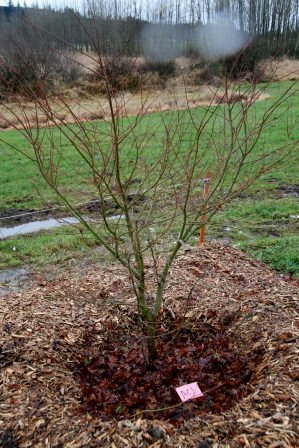
Installed maple
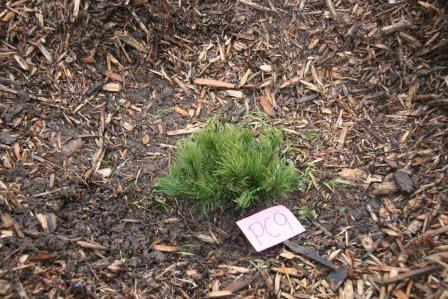
Installed pine
Look at some of the surprises we uncovered during root preparation! I will say unequivocally that these were the WORST quality trees I’ve ever seen coming out of a nursery. And they weren’t cheap.
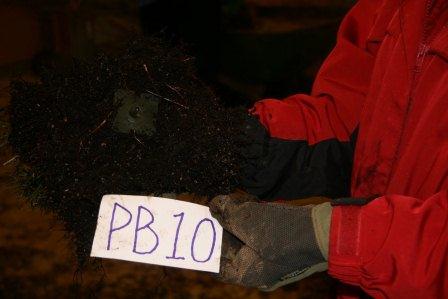
Yes, that’s a 4" pot still covering the roots inside this "gallon" mugo pine.
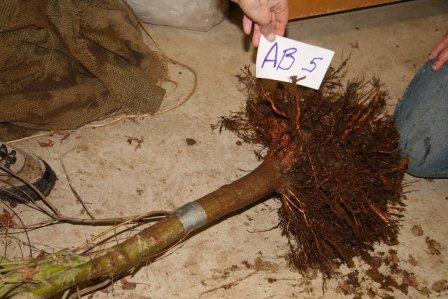
The duct tape is where the top of the burlap was in the original B&B. Every one of the B&B trees we bare-rooted was buried too deeply in the clay and burlap.
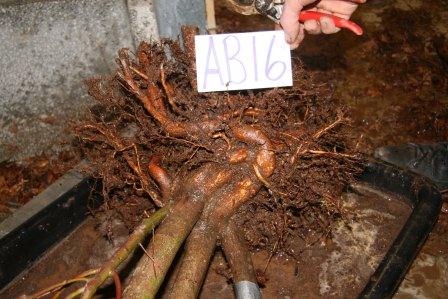
Multiple trees? Multiple messes!
Stay tuned for more…
Any thoughts on why nurseries bury the trees so deep? How can that be beneficial to the nursery? Maybe the plants appear to have a bigger root ball and customers will pay more? Just wondering. Surely somebody has told them it’s not good for the plants.
Sandy, it’s my understanding that when mechanized field digging is done, soil is pulled up around the trunk and then balled. These hadn’t been balled very long, but I’ve seen others where the trunk has rotted after being in this dark, wet environment over the months it sat at the retail nursery.
The main problem I see with this practice, however, is that customers will plant the tree “at grade” based on where the top of the burlap is – which for all of these trees would have been too low.
Yay! I’ll be very, very interested to see the results from this.
Did all 80 trees come from the same source? Sin
ce you can’t closely examine the roots of the conventionally planted trees could they be ‘better’ or ‘worse’ than the bare-root and affect the results?
Kenny, all the trees were from the same source and as “identical” as you can get in real life. So the roots should be pretty much the same among the 40 trees of each species. When/if they die, I’ll exhume the remains and see if the roots of the dead trees had ever established.
Linda, what a great experiment! Thanks, thanks, thanks for doing it, and for enduring those days of planting that many trees.
Sandy and Linda: I’ve been digging trees for about 15 years now with a variety of different mechanical spades — Usually the digging process doesn’t lead to extra soil around the stem. Instead, it’s a combination of the grower planting too deeply (to try to stop trees from tipping over — it doesn’t usually work too well), and cultivation of the fields (when fields are cultivated soil tends to build up around the trees trunk). I’ll be interested to see the results! But I’m very interested to know — What size were the trees when they went in, how long had they been in the ball prior to planting, were they hand balled or machine balled, and was planting depth corrected for all trees or just trees that were washed?
Jeff, we will be taking measurements on the trees later this month; we just didn’t have time in December. The maples were around 5-6′ tall. The balls were mostly soil and very little root – virtually no fine roots which leads me to believe they weren’t in the field very long. And the malformed roots just reinforce that belief. Past that, since we got them from a wholesaler, we don’t know what the production nursery did.
In terms of how we planted them, all the bare-rooted ones were planted with the root flare at grade. The intact ones were about the same. Of course, since we are following “conventional” planting techniques, we couldn’t disturb the ball too much other than to remove the twine and burlap (and even that’s heretical according to some people). We gently brushed soil from the top of the ball and sometimes could find the flare. Other times we could not without destroying the ball, and so we planted it as high as possible.
Thanks Linda! Sounds reasonable to me. Also sounds like the seller was digging with an oversized spade to make extra money. You should check to see whether the ball size matched the recommended ball size based on the American Standards for Nursery Stock. I look forward to results!
has this type of experiement not been done before?
After reading suggests for washing off the soil on some discussion forums, I tired it with one tree that had a root ball that was very heavy clay. The tree really suffered from the treatment and almost died. After 4 years it is starting to look good again. It was a Pinus reflexa ‘Vanderwolf. I know it is just one tree but after that I never washed the root ball off again.
Robert, there have been some studies, but they’ve not been long term, nor have they been done on this side of the country. Plus, some people are so skeptical of the process that we really need more controlled studies that bring more data to the discussion. Right now there are a few controlled studies and lots of anecdotal evidence.
Thanks for doing this study, Linda. And I am truly appalled about the trees being planted too deeply. We tell our clients to plant to the same depth as the nursery has the tree planted in the pot. We trust the nursery professionals to do right by the plants. I don’t care WHY they are getting it wrong. I just want them to fix their methods… even if that means higher cost.
It’s a way higher cost to have to replace a tree later down the line because it was planted too deeply than it is to do it right from the get-go.
I’ve tried to teach my clients what to look for in planting. It’s rather depressing to see what is coming out of some nurseries.
Thanks for your work.
Thank you MUCH for your efforts and commitment to tree research, esp your evaluations of planting methods. I am so often wearied by the lore and misguided “knowledge” of growers and contractors. I will be employing your blog and research heavily to infom myself and my clients.
Any follow up planned for the Christmas from Hell study?
Regards! Mark
Linda:
How are they coming along now? Any preliminary results?
Yes, thanks for the compliment (intrepid). I was also impressed with the not-cheap, root-challenged trees I scared up. It seems to be an ongoing talent of mine.
Please keep us posted.
Yours in freezing mud,
Cindy
Master of Environmental Horticulture
Sadly, the trees have not done well. The moles completely ruined the area, burying many of the pines. I kept them cleaned off, but the poor drainage in that clay soil also meant that most of the Japanese maples died except for those farthest uphill. I’m hoping to repeat the experiment with species that will tolerate the wet soil conditions. Suggestions???